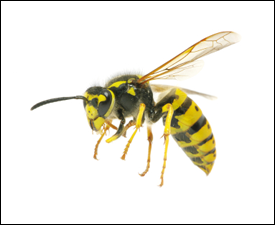Flying Insects
Fabric Pests
Rodents
Bees & Wasps
 Pest-Gone, LLC, the top professionals in bee and wasps pest control in NJ and bee and wasps removal in NJ with over 20 years of expertise and experience. Whether it’s your NJ home or business; Pest-Gon, Inc. will provide a detailed inspection of your property for bees or wasp nests and resolve your wasps pest control problem. Calling a professional is a must when dealing with such vicous insects such as wasps. Our technicians are highly trained in wasps removal and will come out to your home or business and safely remove any nest on your property.
Pest-Gone, LLC, the top professionals in bee and wasps pest control in NJ and bee and wasps removal in NJ with over 20 years of expertise and experience. Whether it’s your NJ home or business; Pest-Gon, Inc. will provide a detailed inspection of your property for bees or wasp nests and resolve your wasps pest control problem. Calling a professional is a must when dealing with such vicous insects such as wasps. Our technicians are highly trained in wasps removal and will come out to your home or business and safely remove any nest on your property.
Wasps are regarded as nuisance pests, particularly at the end of the summer when worker wasps indulge in their passion for sweet materials. The sting is caused by an injection of venom into the victim and can be extremly painful. Unlike the sting of a bee, the wasp sting can be withdrawn from the victim and used again. These insects should never be handled without a professional so dont hesistate to call Pest-Gon, Inc for any wasps pest control problem. Pest-Gon, Inc. uses eco-friendly and effective NJ bee and wasp inspection and wasps removal service so your family, friends or employees will be free of any bee or wasps concerns. Pest-Gon. Inc. is setting the standard for a healthy environment.
Call Pest-Gon, Inc. NJ Pest Control to speak to our bee or wasp control professional today at 732-356-0024!
“We Always Guarantee our Work”
Please read below to learn more about our Bee and Wasps Control Services in NJ
Bees are generally social insects, with a marked division of labor between the various types of bees in the colony. A colony of bees includes a queen, males (drones) and workers.
The queen is the only sexually developed female in the hive. She is the largest bee in the colony. A two-day-old larva is selected by the workers to be reared as the queen. She will emerge from her cell 13 days later to mate in flight with approximately 18 drones. During mating, she receives several million sperm cells, which will last her entire reproductive life span of nearly two years. The queen starts to lay eggs about 10 days after mating. A productive queen can lay up to 3,000 eggs in a single day.
Drones are stout male bees that have no stingers. Drones do not collect food or pollen from flowers. Their sole purpose is to mate with the queen. If the colony is short on food, drones are often kicked out of the hive.
Workers, the smallest bees in the colony, are sexually undeveloped females. A colony can have 20,000 to 60,000 workers. The life span of a worker bee varies according to the time of year. Her life expectancy is approximately 21 to 35 days. Workers that are reared in September and October, however, can live through the winter. Workers feed the queen and larvae, guard the hive entrance and help to keep the hive cool by fanning their wings across the openings. Worker bees also collect nectar to make honey. In addition, honeybees produce wax comb. A Honeybee comb is composed of hexagonal cells, which have walls that are only 2/1000 inch thick, but support up to 25 times their own weight. A bees' wings stroke 11,400 times per minute, thus making their distinctive buzz.
Wasps can be regarded as beneficial insects. As the nests develop during the spring and early summer the workers collect insect larvae and thereby help control insect pests. In general, however, wasps are regarded as nuisance pests, particularly at the end of the summer when worker wasps indulge in their passion for sweet materials e.g. jam, plums, apples, pears. It is the ability of wasps to cause painful stings that concerns most people. The sting is caused by an injection of venom into the victim; unlike the sting of a bee, the wasp sting can be withdrawn from the victim and used again.
By the end of the summer a nest may contain 20,000 plus wasps. With the onset of severe weather the nests die out. The Queens which are larger than the workers over winter in harborages such as garden sheds, buildings, under loose bark and bird boxes. The Queens emerge in the spring and build their nests laying eggs. Four to six weeks after the eggs are laid, the first generation of wasps emerge and the life cycle begins again.
